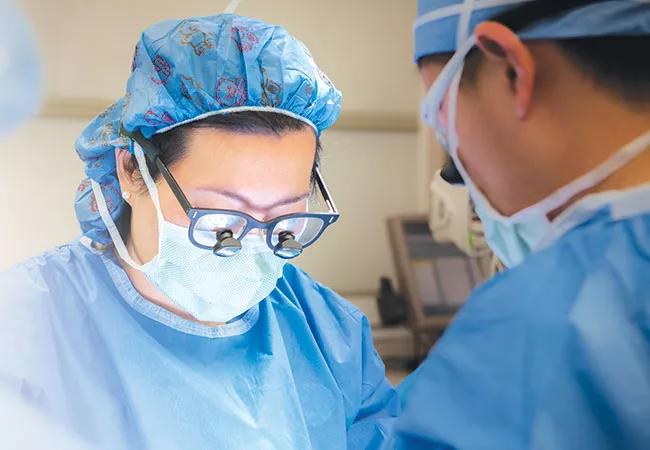Neovagina created from a 12 cm sigmoid segment

Re-creating a missing or malformed body part is one of surgery’s biggest challenges. Cleveland Clinic pediatric urologic surgeon Audrey Rhee, MD, faced that prospect when a 17-year-old patient born without a vagina contacted her in March 2016.
Advertisement
Cleveland Clinic is a non-profit academic medical center. Advertising on our site helps support our mission. We do not endorse non-Cleveland Clinic products or services. Policy
At birth the patient was diagnosed with complete androgen insensitivity syndrome. Although the patient possessed a Y chromosome, unresponsiveness to androgenic hormones prevented masculinization during fetal development, and she was phenotypically female. Her genitalia were somewhat ambiguous but mostly female. Gonads were in the expected position of the ovaries and were surgically removed when the patient was 8 months old. At age 11 she began supplemental estrogen for secondary sexual development and bone mineralization.
As the patient prepared for college, she decided that she wanted a functional vagina. “She wanted the ability to have a sexual relationship, which most of us take for granted,” Dr. Rhee says. “She wanted to be like her peers. I spoke to her extensively to make sure she was ready for the surgery. I give credit to her family, who completely supported her decision.”
Surgeons have devised numerous vaginal reconstruction techniques, including grafting autologous skin or mucosal tissue, tissue-dilation balloon vaginoplasty, transplantation of acellular porcine intestinal submucosa, and autologous bowel (either ileum or sigmoid colon) vaginoplasty. The latter technique, which the patient opted for, was introduced in 1904 but is relatively uncommon. Dr. Rhee had performed the procedure twice prior to joining the institute faculty in 2012.
Dr. Rhee elected to use a vascularized sigmoid segment, which is more robust and trauma- resistant than the ileum, produces less mucus and can be easily repositioned due to its proximity to the perineum.
Advertisement
The complex 12-hour laparoscopic procedure involved two pediatric urologic surgeons and two pediatric general surgeons. The neovagina was created from a 12 cm sigmoid segment that was fashioned into a pouch, rotated with its blood supply into the plane between the bladder and rectum, and secured by suturing the proximal, open end of the pouch to the dissected neo-introitis in the perineum and suturing the distal end to the sacral promontory. Dr. Rhee performed a labiaplasty using bilateral V flaps to construct the labia majora and redundant tissue around the clitoris to form the labia minora, and created a clitoral hood. The surgeons also performed laparoscopic excision of the prostatic utricle to correct urinary incontinence.
Recovery was uneventful. The patient must dilate her neovagina daily to avoid stenosis. Clitoral sensation and mucus secretion are normal.
“This procedure has given her the ability to be intimate with a partner and to be as honest and open as she wants,” Dr. Rhee says. An advantage of having the surgery at Cleveland Clinic, Dr. Rhee says, is the extensive institutional experience in minimally invasive urologic surgery and the teamwork among pediatric and adult caregivers, making the transition of patients with congenital conditions to adult care seamless.
Advertisement
Advertisement

Experts are challenging the one-size-fits-all paradigm

Quality improvement project addresses unplanned extubation

Cardiac imaging substudy is the latest paper originating from the VANISH trial

Consortium makes key recommendations to improve prevention practices

New course offers insights into clinical, psychosocial and ethical dimensions of care

National database study reveals insights into survival outcomes

Exploring the role of caregiver education and objective feedback on speech and language outcomes

Key themes and insights into the family-caregiver experience